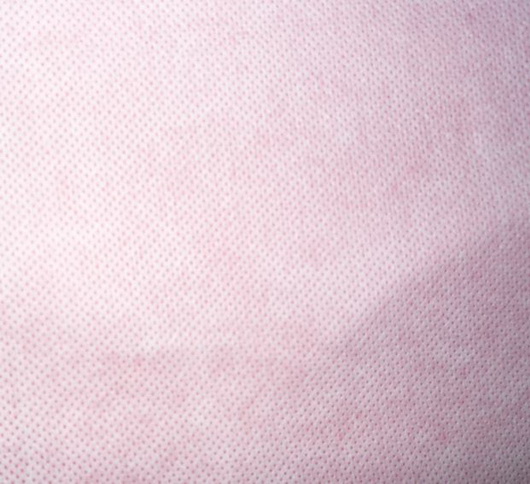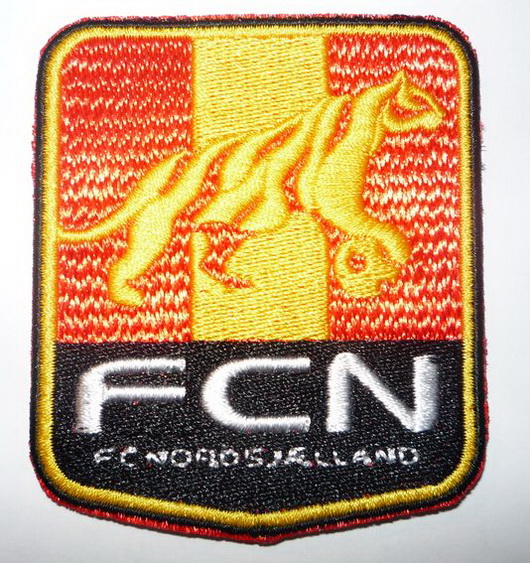Original text by Marina Belova
I'm back on the topic of chevrons and today I'm going to examine the basic technology of creating a badge. Woven fabrics like gabardine or twill, non-woven fabrics like felt and special materials like Step, Twilly and Canvay may serve as a background.
These special materials were manufactured for appliqués and patches. They often have an embroidery-like texture. This helps to save on stitches. For example, you don't have to embroider the background. This is Gunold Step viewed from the right side:

Its wrong side is made of something similar to adhesive spunbond (poly mesh). I think it's done not only for sticking it to the fabric but also for better stabilization.

This material is dense and nice on the touch.
I won't labor the point of producing chevrons with serging the edges after embroidery. For I don't have an overlock machine of that kind, how am I supposed to write about it? Additionally, I don't see any sense in doing so. That process is simple: embroider, trim perimeter-wise and serge the edges. I'm more interested in trimming the edges of a fully embroidered chevron and embroidering a chevron on a blank.
First, I'll tell you about a chevron created on a blank, where the edges are already serged. The digitizing process:
- You create a pattern of your future chevron. To do this, you scan the chevron and digitize its shape along the perimeter with a running stitch. In the end of this stitch, there is a stop and the frame comes out.
- Create a design on the blank.
- The embroidery process is simple and somehow resembles the creation of a traditional patched appliqué:
- You hoop the stabilizer with an adhesive layer on one side and something akin to Filmoplast on the other. The adhesive side should be facing up. You remove the protective layer from the stabilizer. If you don't have such a stabilizer, you can use an ordinary one but with a temporary spray adhesive.
- The sequence is loaded into the machine. The machine embroiders the first outline, makes a stop and the frame comes out.
- The blank is glued to the stab, fitting in the outlined area.
- Embroider the entire design.
- Unhoop the stabilizer and tear it away from the badge.
- Apply the adhesive.
The interesting point is that they don't sell these blanks where I live. Or I just haven't heard about them. Although there is a variety of shapes and sizes in the USA and Europe. Here I only saw them once, at the Textillegprom exposition. To me, it seems strange to make them by hand instead of just embroidering the chevron and not overcomplicating things.
Let's get to the completely stitched chevrons. I've seen two variations of a technique:
- In 1 go.
- In 2 steps.
The first one goes like this:
- Hoop the fabric together with 1–3 layers of the dense tear-away stabilizer. The fabric may be strengthened with a fusible interfacing material.
- You may additionally hoop the buckram with the fabric. In other words, you can play around.
- Embroider the entire design.
- Unhoop and trim. You can either trim by hand or use a laser cut. Some additionally singe the edges using various devices ranging from a lighter to even a blowtorch. Each in their own fashion.
- Then you apply the adhesive.
To embroider a chevron in one go, you digitize it in the simplest way possible:
- First, digitize the entire design.
- Then, add a finishing border. The border should be no less than 3 mm thick. You can also do a double layer border. The second layer is laid along the outer edge. It is thinner and half as dense as the border. It will work as a protective layer in case you accidentally damage the stitches while trimming. I wrote about it here.
This is a badge of some European soccer club I embroidered on fabric. I used Step as a base. This is my second chevron; that's why I picked a simple design for it. Everything here is easy except the letters at the bottom. These letters, they didn't come out as planned at all. They are only 2 mm high. But I think I can tinker with them a bit more to make them readable.

Embroidering a chevron in 2 steps is very much like making an appliqué to a ready pattern:
- You hoop the fabric together with the dense tear-away stabilizer. If necessary, it may be additionally strengthened, as described above.
- Embroider the entire design. Stitch the running stitch instead of a border.
- Then unhoop the whole thing and trim along the perimeter.
- Hoop 1 layer of the tear-away stabilizer.
- Stitch a basting stitch. The machine stops and the hoop comes out.
- A blank that was made and cut out prior to the embroidery is glued to the outlines area of the stabilizer with a temporary spray adhesive.
- Embroider the finishing border.
- Detach the chevron from the stabilizer.
- Apply the adhesive.
Digitizing for the embroidery in 2 steps:
- First, digitize the entire design.
- After that, digitize the stitch according to which the chevron will be cut out.
- Copy this stitch to the new file. It will be a guideline for positioning of the chevron. After that, you add a stop command and the hoop coming out.
- Digitize the finishing border. The border should be no less than 3 mm thick. The recommendations listed above also apply here.
- Actually, there are many ways of creating borders, you only have to choose the one suitable for your purpose.
P.S. I think that digitizing chevrons is hardly different from digitizing ordinary designs. The same principles are applicable here: you consider compensation values, use underlay, pay close attention to the areas where the objects meet, and so on. Only with chevrons, you have to choose the values more carefully in order to achieve a high-quality result. This is true for all types of chevrons, whether the completely stitched ones or the ones embroidered on a background.
Of course, you don't always use a special fabric because of its cost. Consequently, you have a reason for looking around and trying a sharkskin (a tent-cloth; you can also consider slicker fabrics), a gabardine or an ordinary blended diagonal fabrics (or a blended/completely synthetic twill) – all of the materials on the list being substantially cheaper than the sewing twill mentioned above.
Edited by Irina


There are no reviews to display.